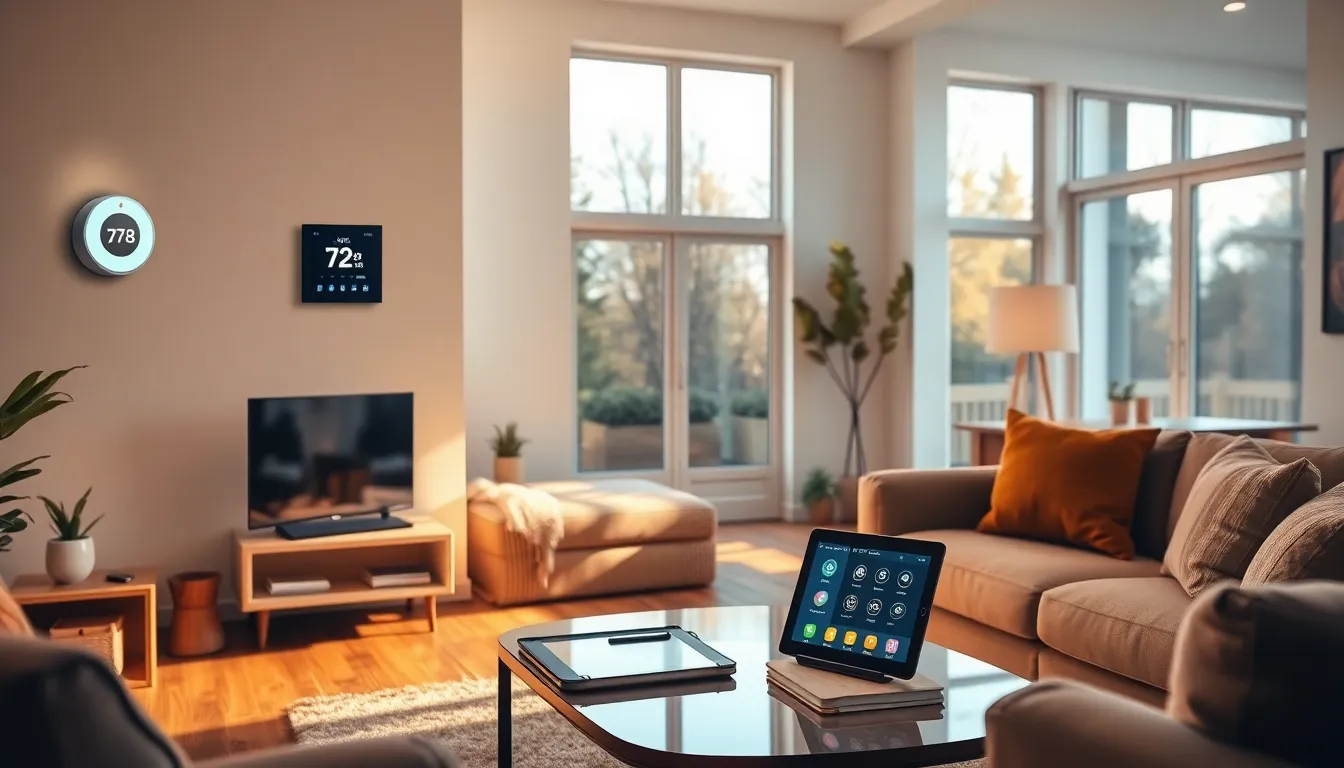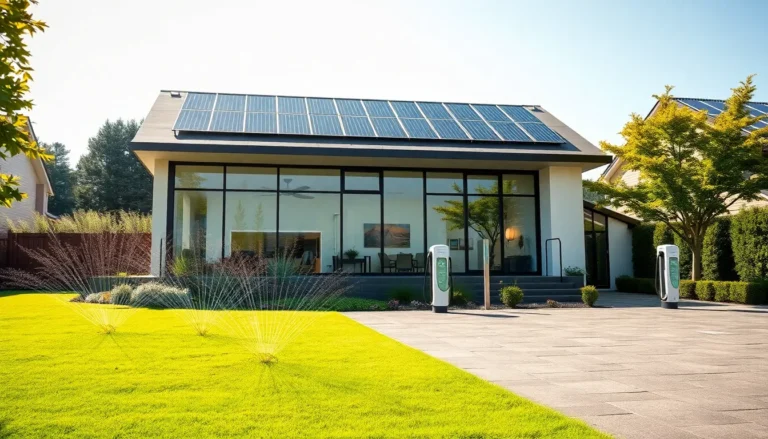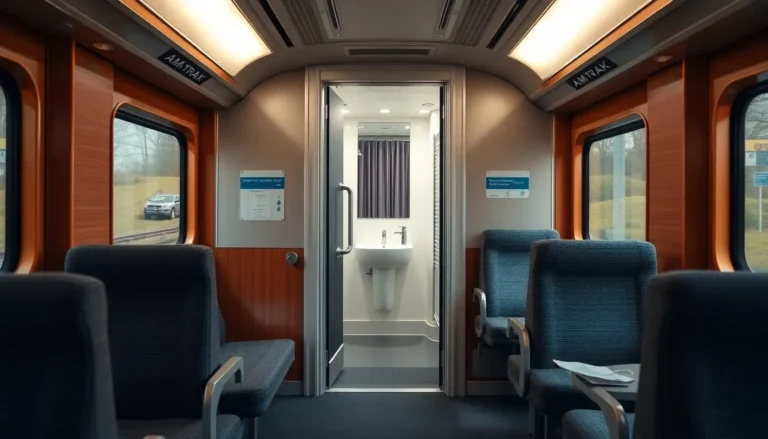Imagine waking up to the sweet sound of your coffee maker brewing while your blinds gently rise, letting the sunlight flood your room. Sounds like a scene from a sci-fi movie, right? Welcome to the world of home automation, where everyday tasks get a futuristic upgrade. It’s not just about convenience; it’s about transforming your home into a smart sanctuary that caters to your every whim.
Table of Contents
ToggleOverview of Home Automation Ideas
Home automation encompasses various technologies that enhance daily life and streamline household tasks. Smart lighting systems, for instance, allow users to control their home’s ambiance through a mobile app or voice commands. Thermostats, such as the Nest Learning Thermostat, adjust heating and cooling based on user preferences and habits, optimizing energy use and comfort.
Security features play a crucial role in home automation. Smart cameras offer real-time monitoring and notifications, ensuring peace of mind. Sensors can detect motion and alert homeowners immediately to unusual activity. Integration of door locks with smart devices enhances security while providing convenient access control.
Entertainment options also benefit from automation. Smart speakers can play music, answer questions, and control other smart devices, creating a centralized hub for home entertainment. Users often enjoy audio experiences throughout their homes through multi-room audio systems.
Energy management represents another significant aspect of home automation. Smart plugs allow for remote monitoring of energy consumption, helping to identify areas for efficiency improvement. Solar panel integration can further enhance energy independence and sustainability.
The integration of home automation systems enables seamless communication between devices. Using platforms like Google Home and Amazon Alexa creates an interconnected experience where commands can control multiple devices simultaneously. Homeowners often appreciate the convenience of scheduling tasks or creating routines that fit their lifestyles.
An array of home automation ideas enhances daily living, addressing connectivity, security, and convenience. Each innovation complements the others, creating a cohesive, efficient home that meets modern demands.
Benefits of Home Automation

Home automation provides numerous advantages that enhance daily living. It empowers homeowners to create a tailored living experience.
Enhanced Convenience
Convenience plays a central role in home automation’s appeal. Smart devices simplify everyday tasks, such as adjusting lighting and temperature using voice commands. Automated routines can trigger actions based on specific schedules. For instance, an evening scene could dim the lights and start the music automatically. Mobile apps allow users to manage devices remotely, granting peace of mind while away from home. Smart appliances streamline chores, reducing the burden on household tasks.
Increased Security
Security remains a top priority for homeowners. Smart cameras offer real-time monitoring and help identify visitors or intruders. Alerts from motion sensors ensure immediate notifications of unusual activities. Remote access to security feeds empowers users to check their homes from anywhere. Integration with other smart devices enhances protection, enabling automated responses like locking doors or turning on lights when motion is detected. Home automation systems contribute significantly to a safer living environment.
Energy Efficiency
Energy efficiency optimizes household energy consumption. Smart thermostats learn user preferences, automatically adjusting temperatures for comfort and savings. They can reduce unnecessary heating or cooling when homes are unoccupied. Furthermore, smart plugs allow for monitoring energy usage from various devices. Users can easily schedule operations to minimize energy waste during off-peak hours. Solar panel integrations support sustainability while reducing electricity bills, making home automation a valuable investment.
Popular Home Automation Ideas
Home automation offers practical solutions that enhance comfort and security while reducing energy costs. The following ideas showcase various ways to integrate technology into daily life.
Smart Lighting Solutions
Smart lighting systems allow homeowners to control ambiance easily. Users adjust brightness and color through mobile apps or voice commands. Custom schedules can optimize energy use, ensuring lights turn off when rooms are unoccupied. Examples include Philips Hue bulbs that sync with music for an immersive experience. Integrated motion sensors automatically illuminate spaces, providing convenience and safety during nighttime.
Automated Climate Control
Automated climate control promotes energy efficiency and comfort. Smart thermostats learn user preferences, adjusting temperatures throughout the day. Devices like the Ecobee SmartThermostat can be controlled remotely, enabling homeowners to manage their home’s climate even when away. Automated shades regulate sunlight, reducing heating costs in summer and maximizing warmth in winter. These features create a balanced living environment year-round.
Home Security Systems
Home security systems protect properties with advanced technology. Smart cameras monitor areas in real-time, providing alerts for unusual activity. Users can view live feeds through their smartphones from anywhere. Motion sensors detect movement and notify homeowners immediately. Many systems incorporate smart locks that enable keyless entry and grant access remotely. Collectively, these features enhance overall safety and peace of mind.
Voice-Activated Assistants
Voice-activated assistants simplify control over various devices. Integrating Amazon Alexa or Google Assistant enables hands-free management of lighting, climate, and security. Users ask questions, set reminders, or play music with simple voice commands. These assistants can create routines that automate multiple tasks, like turning off all lights at bedtime. Their seamless integration fosters a connected, smart home environment.
DIY Home Automation Projects
Home automation projects enable individuals to create personalized smart homes. Engaging in these projects often enhances comfort and efficiency.
Setting Up Smart Devices
Smart devices simplify daily tasks through various automation features. Choose energy-efficient smart bulbs that adjust brightness and color based on preferences. Install smart plugs to remotely manage devices and track energy consumption. Tablet or smartphone apps facilitate easy control of security cameras and thermostats. Configure routines to automate lighting or climate settings throughout the day. Voice assistants support hands-free management of devices, providing seamless interactions.
Creating a Smart Home Hub
A smart home hub centralizes control of connected devices, enhancing user experiences. Selecting a compatible hub like Samsung SmartThings or Hubitat expands device interoperability. Establish connectivity with various smart devices to create an integrated system. Add protocols such as Zigbee or Z-Wave for extensive compatibility. Utilize mobile apps to monitor and manage device settings remotely. Automate routines by scheduling commands for devices based on preferences or time of day.
Future Trends in Home Automation
Anticipating advancements in home automation shapes the future of intelligent living. Voice recognition technology is evolving to provide more accurate and personalized interactions with smart devices. Users will experience more seamless control over their environments as natural language processing improves.
AI-driven systems are set to redefine how homes respond to their inhabitants. Machine learning algorithms enable devices to adapt based on user behaviors, enhancing comfort and efficiency. Automating everyday tasks with smarter routines ensures systems react dynamically to needs.
Integration of IoT devices is becoming more prevalent. This approach allows various home devices to communicate effectively, creating a cohesive ecosystem. An interconnected home maximizes the potential of automation technologies by blending lighting, climate control, and security features.
Sustainability is increasingly prioritized in home automation designs. Smart energy management systems optimize power usage, reducing consumption and costs. Emerging technologies, like solar panel integration with home energy management systems, promote eco-friendly living.
Security technology will advance significantly. Biometrics, such as facial recognition and fingerprint scanning, provide enhanced safety measures. These innovations will enable more secure smart entry systems, minimizing vulnerabilities and improving overall protection.
User-friendly interfaces are essential for broader adoption. Simplified mobile applications and control centers allow all family members to engage with automation systems easily. Future designs will prioritize accessibility to ensure technology serves everyone, regardless of technical expertise.
Cloud-based solutions will enhance data storage and processing capabilities. Homes will harness the power of the cloud to perform complex calculations and tasks without lag. This transformation will lead to smarter, more responsive environments that evolve with user needs.
Embracing home automation transforms everyday living into a seamless experience. By integrating smart devices and systems homeowners can create a personalized environment that enhances comfort and security while promoting energy efficiency. The possibilities are endless from automated lighting to advanced security features that provide peace of mind.
As technology continues to evolve the future of home automation looks promising with innovations that will further simplify daily tasks and enhance user interaction. Investing in these systems not only improves convenience but also paves the way for a more sustainable lifestyle. Adopting these home automation ideas will surely elevate any living space into a smart sanctuary tailored to individual needs.


